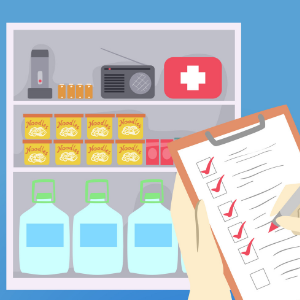
While we’re halfway through a (thankfully) quiet Atlantic hurricane season, that’s no reason to let your guard down. Not only are we approaching the peak of the season, there are countless other natural disasters that can harm your business’s IT network at any time of the year.
Ideally, of course, you would have completed your hurricane preparations before the season began. But you can still safeguard your technology if a storm is imminent with this storm prep checklist from our Technology Solutions Consulting team.
- Check your data backup system to make sure it’s working. Do a test restore of sample data if possible.
- If you don’t do a regular backup, perform one now and make sure it is taken to a safe place away from your business. (Storing it offsite with a cloud provider such as Microsoft is a great way to protect your data.)
- Move electronics away from windows.
- At your desks, unplug all electronic devices and clear/put away important papers.
- Cover computers with plastic tarps or trash bags. Take laptops home.
- Make sure there are no electrical devices on the floor (such as computers, power strips and dictation machine foot pedals). Raise them at least 6 inches.
- Pack hardcopies of important documents that don’t have electronic versions (for example, insurance certificates, contracts, financial documents, etc.). Place them in waterproof plastic bins with good seals.
- Distribute lists of vendor phone numbers, account passwords and other critical information to those who need it.
- Choose an alternate location for business if your office sustains too much damage for your normal operations. Make sure it has adequate power for your needs.
- Keep a list of recovery phone numbers:
- FEMA: 1-800-621-3362
- Small Business Administration (disaster loans): 1-800-659-2955
- Your insurance company’s claims hotline
Even if a hurricane isn’t approaching, you can (and should) take steps now to protect both your data and your physical workplace. Here are some other storm preparation tips:
Review your plans for disaster recovery and business continuity. If you don’t have these plans in place, check out our article on how to get started.
Create a secure environment for your electronic and mechanical equipment. Keep servers, CPUs and battery backups off the floor and away from windows to avoid flood and debris damage. Also make sure that gas tanks, water heaters and other similar items are held solidly in place.
Keep supplies on hand to barricade windows and doors from debris. Despite the popular myth, applying tape to your windows in an “X” shape will not work. Plywood, nails and a hammer will generally do the trick. Store these materials in a place that provides quick and easy access. Your better option is to install storm shutters over these points of entry. They’ll cost more but will be a lot easier to use in the rush before a storm.
Make sure your building and its surroundings are structurally sound. Have your roof inspected by a professional to ensure storm hardiness, and hire an arborist to examine the trees surrounding your building and trim any branches that could fall and cause damage during a storm.
Minimize large objects near/around your building. This includes tools, outdoor furniture, stand-alone signage and anything else that can be picked up by strong winds. Make it a habit to store them in a shed or other secure place to minimize your last minute storm prep work.
Make sure your interior furniture is steady. Anchor or brace tall/large furniture, such as bookcases, to wall studs to keep them from tipping over easily if the building experiences movement.
You can also check out the FEMA Business Toolkit for more in-depth information on storm preparation based on the size of your business and other factors. And as always, contact James Moore for help in putting together your disaster recovery and business continuity plans.




